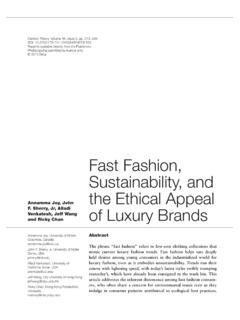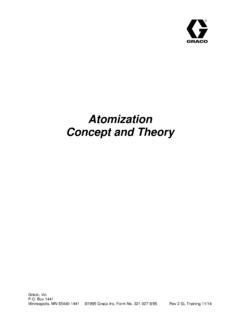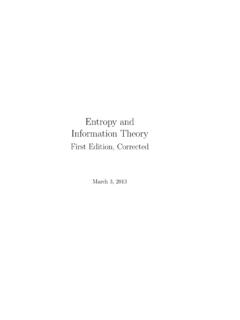Transcription of Critical Race Theory and Education History, Theory, and …
1 Critical Race Theory and Education : History, Theory , and Implications Author(s): William F. Tate IV. Source: Review of Research in Education , Vol. 22 (1997), pp. 195-247. Published by: American Educational Research Association Stable URL: Accessed: 22-10-2018 15:43 UTC. JSTOR is a not-for-profit service that helps scholars, researchers, and students discover, use, and build upon a wide range of content in a trusted digital archive. We use information technology and tools to increase productivity and facilitate new forms of scholarship. For more information about JSTOR, please contact Your use of the JSTOR archive indicates your acceptance of the Terms & Conditions of Use, available at American Educational Research Association is collaborating with JSTOR to digitize, preserve and extend access to Review of Research in Education This content downloaded from on Mon, 22 Oct 2018 15:43:01 UTC. All use subject to Chapter 4.
2 Critical Race Theory and Education : History, Theory , and Implications WILLIAM F. TATE IV. University of Wisconsin-Madison In 1993 President Clinton nominated Professor Lani Guinier of the University of Pennsylvania Law School to be assistant attorney general in charge of the Civ Rights Division. Her nomination for this government post resulted in a large con troversy centering on her scholarship (Guinier, 1991a, 1991b). Guinier's research which examined voting systems, asked the following question: Are there factors th guarantee winners and losers? She contended that such factors do exist and that rac is too often an important factor in the construction of voting districts, the outcome of elections, and ultimately political influence, including the control of educationa systems. Guinier (1989) argued that the political system must be rejuvenated to b more inclusive. Specifically, she called for the creation of electoral schemes tha would allow Blacks to elect candidates representing their interests.
3 These schemes-proportional voting, in particular-were already a reality in many south ern localities and had received endorsement from the Reagan-Bush Justic Department and the Supreme Court. Professor Guinier also was Critical of politic bargaining between leading civil rights groups, African American politicians, an Republicans that resulted in the construction of guaranteed African American leg islative districts and conservative White districts in adjacent jurisdictions. Guinier's position sparked great controversy among both liberals and conservatives. In the epilogue of Racial Formation in the United States, Omi and Winant (1994. posited that this controversy had little to do with Guinier's position on the issue of voting districts; rather, her "sin" was her eagerness to discuss the changing dimen- sions of race in contemporary politics. Omi and Winant (1994) remarked: Guinier's recognition that, in the post-civil rights era as previously, racial injustice still operates, th it has taken on new forms, and that it needs to be opposed if democracy is to advance, in our view located her in a far more realistic position.)
4 Guinier understood the flexibility of racial identities an I would like to thank Michael Apple (editor) and Gloria Ladson-Billings (editorial consultant) fo their feedback on this chapter. Also, a special thanks to Carl Grant, Ron Jetty, Kimberly Tate, an Jessica Trubek for their valuable assistance with this project. 195. This content downloaded from on Mon, 22 Oct 2018 15:43:01 UTC. All use subject to 196 Review of Research in Education , 22. politics [italics added], but also affirmed that racism still shapes the social structure in a wide- spread fashion. She resisted the idea of closing Pandora's box; in fact she denied the possibility of closing it, arguing the racial dimensions of politics are too complex, too basic, and too subtle to be downplayed for long. (p. 156). Ladson-Billings and Tate (1995) asserted that, despite the salience of race in society, it remains untheorized as a topic of scholarly inquiry in Education .
5 ' Over the past three decades, theoretical and philosophical considerations of gender have been delineated and debated (Chodorow, 1978; Damarin, 1995; DeBouvoir, 1961; Harding, 1986; Hartsock, 1979). Similarly, Marxist and neo-Marxist analy- ses of class continue to frame many explanations of social inequality (Apple, 1992; Bowles & Gintis, 1976; Carnoy, 1974; Frankenstein, 1987).2 Although gender-and class-based analyses continue to struggle for legitimacy in academe, educational studies conceptualized on these theoretical precepts abound (see reviews by Ewert, 1991; B. M. Gordon, 1995; Noddings, 1990; Schmitz, Butler, Rosenfelt, & Guy-Sheftall, 1995). Ladson-Billings and Tate (1995) recognized the importance of gender-and class- based analyses; however, they asserted that the significance of race in the United States, and more specifically "raced" Education , could not be explained with theo- ries of gender or Similarly, McCarthy and Crichlow (1993) argued that the subject of racial domination has, to say the least, been treated problematically in modem educa- tional and social theories.
6 Racial logics and mechanisms have been difficult to specify, their persis- tence difficult to explain, and their dynamics and trajectories difficult to predict. Indeed, the very slippery nature of what has come to be known in the educational literature as the "race question" chal- lenges in fundamental ways the entire tapestry of curriculum and educational thought, particularly with respect to nonclass social antagonisms and domination relations in general. That is to say, the race question brings into the foreground omissions and blind spots. (p. xvii)4. These omissions and blind spots suggest the need for theoretical perspectives that move beyond the traditional paradigmatic boundaries of educational research to provide a more cogent analysis of "raced" people and move discussions of race and racism from the margins of scholarly activity to the fore of educational dis- course. King (1995) stated: Conceptual intervention in the educational research literature is needed to facilitate a systemic exam- ination of scholarship that addresses ideological influence on knowledge in curriculum and Education practice, particularly with regard to the Education of Black people.
7 (p. 270). To this end, one important question for scholars interested in educational equity and the politics of Education is, In what theoretical framework did Lani Guinier embed her analyses of race, voting systems, and political equality?5 The answer to this question can be found in an emerging literature in legal discourse referred to as Critical race Theory (CRT). Calmore (1992) remarked: As a form of oppositional scholarship, Critical race Theory challenges the universality of white experi- ence/judgement as the authoritative standard that binds people of color and normatively measures, This content downloaded from on Mon, 22 Oct 2018 15:43:01 UTC. All use subject to Tate: Critical Race Theory 197. directs, controls, and regulates the terms of proper thought, expression, presentation, and behavior. As represented by legal scholars, Critical race Theory challenges the dominant discourses on race and racism as they relate to law.
8 The task is to identify values and norms that have been disguised and sub- ordinated in the law. As Critical race scholars, we thus seek to demonstrate that our experiences as peo- ple of color are legitimate, appropriate, and effective bases for analyzing the legal system and racial subordination. This process is vital to our transformative vision. This Theory -practice approach, a praxis, if you will, finds a variety of emphases among those who follow From this vantage, consider for a moment how law, society, and culture are texts-not so much like a literary work, but rather like the traditional black minister's citation of text as a verse or scripture that would lend authoritative support to the sermon he is about to deliver. Here, texts are not merely ran- dom stories; like scripture, they are expressions of authority, preemption, and sanction. People of color increasingly claim that these large texts of law, society, and culture must be subjected to fundamental criticism and reinterpretation.
9 (pp. 2161-2162). This chapter is structured around the exposition of various sources (authors of CRT articles and philosophers who influenced these authors), followed by com- mentaries that summarize and critique the more descriptive discussions. The reason for this unusual structure relates to the twofold purpose of the chapter. The first pur- pose is to describe the major theoretical elements undergirding CRT. The second purpose is to discuss the potential implications of this body of literature for the scholarly articulation of race and equity in educational policy and research. This discussion will offer a critique of CRT writing that asks whether the methods of analysis and argument, and the research agenda represented by the CRT scholarship described here, are valuable in two ways. First, do they provide insights capable of radically transforming educational policy or the study of Education ? Second, do they provide insights into equity issues in Education that are substantial and novel?
10 OUTLINE OF THE DISCUSSION. This chapter does not include a comprehensive review of the wide range ics analyzed by scholars employing tenets of CRT; rather, it attempts to elements of this Theory especially relevant to educational researchers. Wit mind, the first topic explored is the paradigmatic kinship of educational and the legal structures of society. The intent of this discussion is to how both educational research and legal structures contribute to existin systems and to legitimating social frameworks and policy that result in tional inequities for people of color. The section concludes with a call f ceptual intervention. In the next section, the historical origins and shifting paradigmatic vi CRT are discussed. CRT is a product of and response to one of the most cally active and successful eras of social change in the United States and be divorced from it without losing analytical insight. The CRT movement studies is rooted in the social missions and struggles of the 1960s that sou tice, liberation, and economic empowerment; thus, from its inception, it both academic and social activist goals.





